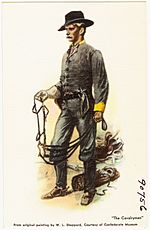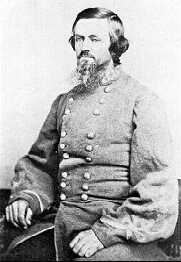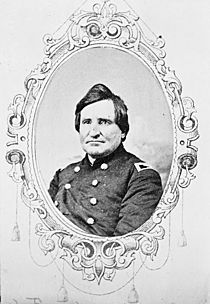Battle of Philadelphia facts for kids
Quick facts for kids Battle of Philadelphia, Tenn. |
|||||||
|---|---|---|---|---|---|---|---|
| Part of the Knoxville campaign during the American Civil War | |||||||
 Confederate cavalryman, painting by W. L. Sheppard |
|||||||
|
|||||||
| Belligerents | |||||||
| Commanders and leaders | |||||||
| Strength | |||||||
| 2 cavalry brigades attached artillery |
1 cavalry brigade, 6 guns | ||||||
| Casualties and losses | |||||||
| 167 | 479, 6 guns | ||||||
The Battle of Philadelphia happened on October 20, 1863, during the American Civil War. It was a fight between Confederate and Union soldiers on horseback, called cavalry. Confederate cavalry groups, led by Colonels J. J. Morrison and George Gibbs Dibrell, attacked a Union cavalry group. This Union group was led by Colonel Frank Wolford near Philadelphia, Tennessee. This battle was part of the larger Knoxville campaign.
The Confederates used a clever plan. While Dibrell's soldiers kept the Union troops busy, Morrison's group rode around Philadelphia. They planned to attack the Union force from behind. Colonel Wolford, the Union commander, tried to stop Morrison's move. But then Dibrell's soldiers attacked directly. The Confederates completely defeated Wolford's troops, capturing over 400 Union soldiers.
The next day, Union soldiers and cavalry returned to Philadelphia. However, a week later, they pulled back across the Tennessee River. This meant they left Loudon, Tennessee behind.
Contents
Why the Battle Happened
On March 25, 1863, Major General Ambrose Burnside was put in charge of the Army of the Ohio. His main goal was to capture East Tennessee. This plan was supposed to happen at the same time as another Union attack. That attack was by Major General William Rosecrans against Chattanooga, Tennessee.
There was a delay of two months because Burnside's soldiers had to help with the Siege of Vicksburg. But on August 24, 1863, Burnside finally began his invasion of East Tennessee. His troops moved in several groups. Burnside's main foot soldiers entered East Tennessee through Kingston. A Union cavalry group entered Knoxville without any fighting on September 1.
As Burnside moved northeast from Kingston toward Knoxville, he left some soldiers behind. Brigadier General Julius White's infantry (foot soldiers) stayed to hold Loudon.
Confederate Retreats
The Union army took over East Tennessee almost without a fight. This was because Brigadier General Simon Bolivar Buckner, the Confederate commander in East Tennessee, left Knoxville on August 22. He followed orders to take his 8,000 troops to join the Army of Tennessee. Before leaving, he burned the railroad bridge at Loudon. He left only small groups of soldiers in East Tennessee.
On September 9, Brigadier General John W. Frazer surrendered 2,000 Confederates. This happened in the Battle of Cumberland Gap. His soldiers were trapped between Union forces. Soon after, the Union army set up a telegraph line. This connected Knoxville with Kentucky.
Changing Plans
The war situation changed a lot after the Confederate victory. This was the Battle of Chickamauga on September 19–20, 1863. The Confederate commander, Braxton Bragg, won a costly victory. He pushed the Union Army into Chattanooga, where they were trapped.
The Union responded quickly. Two large groups of soldiers were sent from the Eastern part of the war. They were ordered to go help Chattanooga. Because of this, Burnside no longer had to go to Chattanooga. Burnside also got more soldiers. Brigadier General Orlando B. Willcox arrived with 3,000 Indiana soldiers on October 3.
Meanwhile, Major General Samuel Jones had 6,000 Confederates nearby. Burnside dealt with this threat. He defeated Brigadier General John Stuart Williams' Confederate force. This happened at the Battle of Blue Springs on October 10. Burnside then pushed them away. Burnside returned to Knoxville on October 14. He left Willcox to protect his northeastern side.
The Battle Unfolds
After Williams' defeat, Jones asked the Confederate government for help. They sent his request to Bragg at Chattanooga. Bragg sent an infantry division led by Major General Carter L. Stevenson. He also sent two cavalry groups under Morrison and Dibrell. Their job was to threaten the Union-held area in East Tennessee.
Stevenson left Bragg's army on October 17. But there was a shortage of equipment on the East Tennessee and Georgia Railroad. So his foot soldiers only reached Charleston on October 19. On that day, Stevenson sent the cavalry groups to attack Philadelphia. This town was about 6 miles (10 km) south of Loudon.
At Sweetwater, about 6 miles (10 km) south of Philadelphia, was a Confederate infantry group. This group was led by Brigadier General John C. Vaughn. These soldiers had been captured at Vicksburg. They had been released, but they were not ready to fight. They did not take part in the battle. However, Vaughn helped plan the attack.
Confederate Plan
Stevenson ordered Dibrell's group to go straight to Philadelphia. They were to attack the Union soldiers at dawn on October 20. Morrison's group got extra soldiers from other units. Morrison was told to get behind the Union force at Philadelphia. He was to work together with Dibrell.
Morrison and Dibrell agreed that Dibrell's group would reach Philadelphia around noon. Morrison later told Dibrell that his troops would not be in position until 2 p.m. Meanwhile, Dibrell used two of his regiments and some artillery (cannons) to fight with the Union cavalry. The rest of his troops stayed hidden.
Dibrell and Wolford's Union cannons fired at each other for over an hour. When Morrison's cannons started firing from behind the Union lines, Dibrell immediately attacked. This attack defeated the Union troops and captured many prisoners. Dibrell reported losing only 1 soldier killed and 3 captured.
Morrison's Attack
Morrison reported that his 1,800 cavalrymen crossed the Hiwassee River on October 19. As they moved west of Philadelphia, Morrison's group captured some wagons and 40 Union soldiers. When he reached a point north of Philadelphia, Morrison cut the telegraph line. He sent one regiment to make a show of force against White's infantry at Loudon. This was to keep them from interfering.
Morrison then moved toward Philadelphia. He faced what he thought was the entire Union force. Morrison's cavalry attacked twice and were pushed back. He called it "one of the hardest cavalry fights of the war." But then they finally defeated the Union soldiers. Morrison reported losing 14 killed and 82 wounded.
Wolford realized Morrison was trying to surround him. He sent Colonel Silas Adams with two Kentucky Cavalry Regiments to stop the move. But they were "cut off." Adams returned to Loudon with 50 prisoners. With his remaining 700 cavalry, Wolford fought Dibrell's group coming from the south.
With Confederates attacking from all sides and his cannons out of ammunition, Wolford gathered his soldiers. They broke out, leaving 6 mountain howitzers (small cannons) behind. They did manage to bring a few prisoners with them.
Union losses were 7 killed, 25 wounded, and 447 captured. The Confederates lost 15 killed, 82 wounded, and 70 captured. Besides the 6 cannons, the Confederates captured 50 wagons full of supplies. They also took 10 ambulances, 75 beef cattle, and many mules and horses.
After the Battle
On October 21, White's infantry and the remaining Union soldiers from Wolford's group advanced. They recaptured Philadelphia. Morrison and Dibrell fell back about 2.5 miles (4 km) northeast of Sweetwater.
When they found that White's troops left Philadelphia on the night of October 21, the Confederates moved back in. They reoccupied Philadelphia the next day. Meanwhile, Stevenson's infantry arrived at Sweetwater on October 22. Burnside reached Loudon on October 23.
The defeat at Philadelphia and reports of more Confederate soldiers coming caused Burnside to pull back. He moved his troops to the north bank of the Tennessee River. On October 28, the Union soldiers left Loudon. This allowed Union-supporting civilians to leave the town.
Burnside planned to hold Kingston and the line of the Little Tennessee River. This was to stop any Confederate attacks from the south. Burnside brought two divisions (6,000 men) to hold the area north of Loudon. He also had White's 3,000 troops. Meanwhile, Milo Smith Hascall's division held Knoxville. Willcox's soldiers defended Bull's Gap. Two regiments and 300 cavalry held Cumberland Gap.
Soldiers in the Battle
| Division | Brigade | Unit |
|---|---|---|
| Martin's Division Major General William T. Martin |
1st Brigade Brigadier General John Tyler Morgan |
"Detachment" |
| 2nd Brigade Colonel J. J. Morrison |
1st Georgia Cavalry Regiment | |
| 2nd Georgia Cavalry Regiment | ||
| 3rd Georgia Cavalry Regiment | ||
| 4th Georgia Cavalry Regiment | ||
| 6th Georgia Cavalry Regiment | ||
| Armstrong's Division Brigadier General Frank Crawford Armstrong |
1st Brigade Colonel George Gibbs Dibrell |
4th Tennessee Cavalry Regiment (Baxter Smith's) |
| 5th Tennessee Cavalry Regiment (McKenzie's) | ||
| 8th Tennessee Cavalry Regiment (Dibrell's) | ||
| 9th Tennessee Cavalry Regiment | ||
| 10th Tennessee Cavalry Regiment | ||
| 2nd Brigade Colonel C. H. Tyler |
Jessee's Kentucky Cavalry Battalion |
| Unit | Killed | Wounded | Missing |
|---|---|---|---|
| 1st Kentucky Cavalry Regiment | 0 | 0 | 127 |
| 11th Kentucky Cavalry Regiment | 1 | 3 | 89 |
| 12th Kentucky Cavalry Regiment | 2 | 13 | 97 |
| 45th Ohio Infantry Regiment (mounted) | 4 | 9 | 134 |




